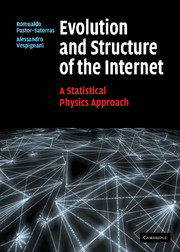Book contents
- Frontmatter
- Contents
- Preface
- List of abbreviations
- 1 A brief history of the Internet
- 2 How the Internet works
- 3 Measuring the global Internet
- 4 The Internet's large-scale topology
- 5 Modeling the Internet
- 6 Internet robustness
- 7 Virtual and social networks in the Internet
- 8 Searching and walking on the Internet
- 9 Epidemics in the Internet
- 10 Beyond the Internet's skeleton: traffic and global performance
- 11 Outlook
- Appendix 1 Graph theory applied to topology analysis
- Appendix 2 Interface resolution and router topology
- Appendix 3 Numerical analysis of heavy tailed distributions
- Appendix 4 Degree correlations
- Appendix 5 Scale-free networks: scaling relations
- Appendix 6 The SIR model of virus propagation
- References
- Index
3 - Measuring the global Internet
Published online by Cambridge University Press: 12 January 2010
- Frontmatter
- Contents
- Preface
- List of abbreviations
- 1 A brief history of the Internet
- 2 How the Internet works
- 3 Measuring the global Internet
- 4 The Internet's large-scale topology
- 5 Modeling the Internet
- 6 Internet robustness
- 7 Virtual and social networks in the Internet
- 8 Searching and walking on the Internet
- 9 Epidemics in the Internet
- 10 Beyond the Internet's skeleton: traffic and global performance
- 11 Outlook
- Appendix 1 Graph theory applied to topology analysis
- Appendix 2 Interface resolution and router topology
- Appendix 3 Numerical analysis of heavy tailed distributions
- Appendix 4 Degree correlations
- Appendix 5 Scale-free networks: scaling relations
- Appendix 6 The SIR model of virus propagation
- References
- Index
Summary
The characterization of how routers, computers, and physical links interconnect with each other in the global Internet is a very difficult task due to several key features of network development. A first one is the Internet's size and continued growth. The Internet is growing exponentially and its size has already increased by five orders of magnitude since its birth. In other words, the Internet is a large-scale object whose global properties cannot be inferred, in general, from local ones. A second difficulty is the intrinsic heterogeneity of the Internet, that is it is composed of networks engineered with large technical and administrative diversity. The different networking technologies are merged together by the TCP/IP architecture that, while providing connectivity, does not imply uniform behavior. Moreover, networks range from small local campuses to large transcontinental backbone providers. This difference in size is reflected in different administrative policies that make routing through the Internet a highly unpredictable and heterogeneous phenomenon. Also very important is the fact that the Internet is a self-organizing system, whose properties cannot be traced back to any blueprint or chart. It evolves and drastically changes over time according to evolutionary principles dictated by the interplay between cooperation (the network has to work efficiently) and competition (providers wish to earn money). This means that routers and links are added by competing entities according to local economic and technical constraints, leading to a very intricate physical structure that does not comply with any globally optimized plan.
- Type
- Chapter
- Information
- Evolution and Structure of the InternetA Statistical Physics Approach, pp. 19 - 35Publisher: Cambridge University PressPrint publication year: 2004
- 1
- Cited by



